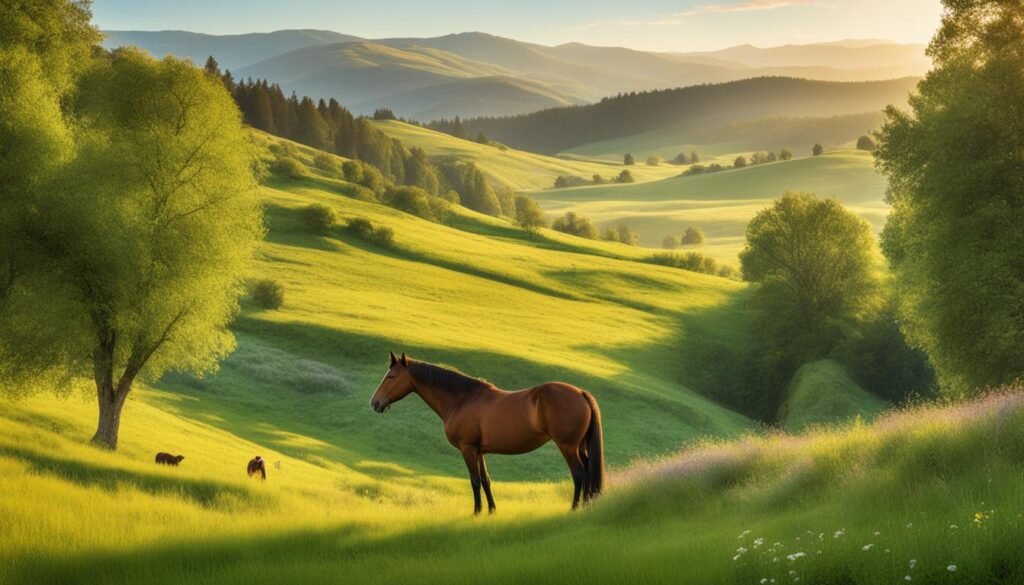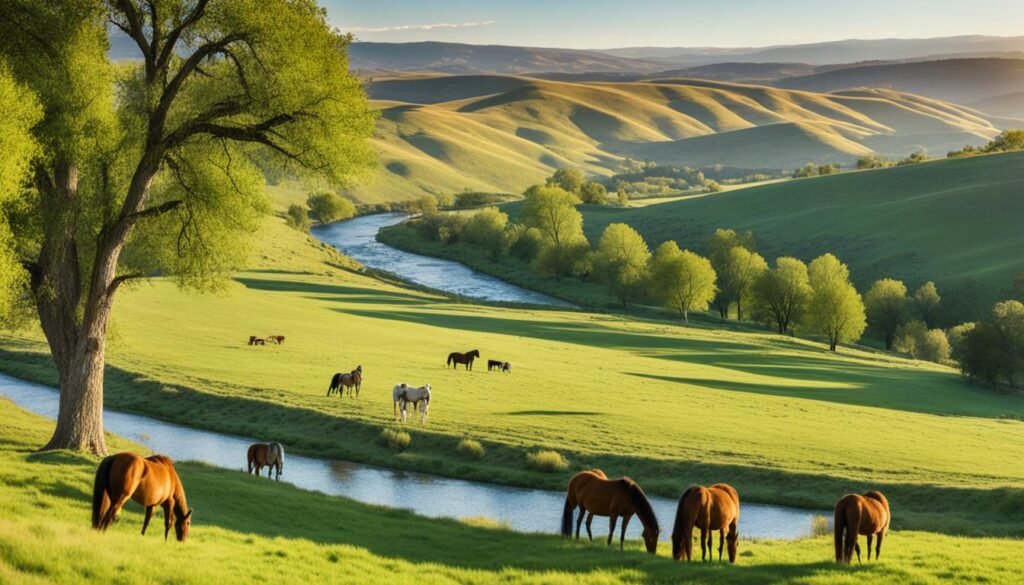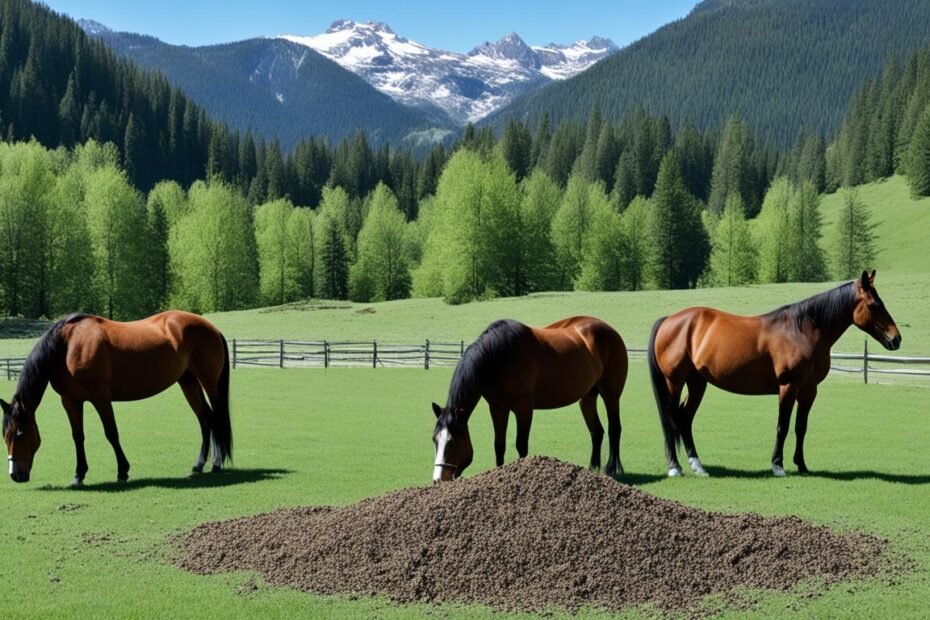Across the globe, a remarkable alliance is emerging between horses and the preservation of culturally significant landscapes. This article delves into the fascinating world of equine conservation grazing, where these majestic animals are playing a crucial role in revitalizing and restoring ecosystems that are deeply intertwined with human heritage and cultural identity.
At the heart of this innovative approach is the recognition that horses, when strategically deployed, can serve as powerful tools for targeted grazing and rangeland rehabilitation.
By harnessing the natural grazing behaviors of these animals, land managers are able to effectively manage vegetation, promote the growth of native plant species, and combat the encroachment of invasive species – all while preserving the rich cultural and ecological tapestry of the land.
Integral to this process is the utilization of heritage breed horses, which possess unique adaptations and foraging habits that make them particularly well-suited for the task.
By working in harmony with traditional ecological knowledge, these horse-powered restoration efforts are yielding remarkable results, breathing new life into bioculturally diverse landscapes and safeguarding the legacies of past generations.
Key Takeaways
- Horses are being used to revitalize and restore culturally significant landscapes around the world.
- Equine conservation grazing is a powerful tool for targeted vegetation management and rangeland rehabilitation.
- Heritage breed horses are particularly well-suited for this task, due to their unique adaptations and foraging habits.
- The integration of traditional ecological knowledge is crucial to the success of these horse-powered restoration efforts.
- Preserving bioculturally diverse landscapes and cultural heritage sites are key priorities in this innovative approach.
Introducing Equine Conservation Grazing
In the realm of ecological restoration, a unique approach is gaining attention – equine conservation grazing. This innovative practice harnesses the power of horses to manage and rehabilitate rangelands and other vital ecosystems.
By strategically utilizing Equine Conservation Grazing, land managers can tackle the challenge of Rangeland Rehabilitation and revitalize culturally significant landscapes.
Targeted Grazing for Rangeland Rehabilitation
Targeted Grazing is a core component of equine conservation grazing, where horses are deliberately placed in specific areas to selectively graze on undesirable vegetation.
This targeted approach helps to suppress invasive species, promote the growth of native plants, and restore the ecological balance of degraded rangelands. The versatility of horses makes them well-suited for this task, as they can navigate challenging terrain and adapt to diverse environmental conditions.
The Role of Heritage Breed Horses
Integral to the success of equine conservation grazing are Heritage Breed Horses. These horses, adapted to local environments over generations, possess unique traits and behaviors that make them invaluable in rehabilitation efforts.
Their innate grazing patterns, hardiness, and adaptability allow them to thrive in the very landscapes they help to restore, ensuring a sustainable and symbiotic relationship between the animals and the land.
| Characteristic | Heritage Breed Horses | Conventional Livestock |
|---|---|---|
| Grazing Patterns | Selective, targeted grazing | Indiscriminate, widespread grazing |
| Adaptability | Highly adaptable to local environments | Less adaptable to diverse environments |
| Hardiness | Robust and resilient to harsh conditions | May require more intensive management |
By leveraging the unique attributes of Heritage Breed Horses, land managers can effectively harness the power of Equine Conservation Grazing to drive the Rangeland Rehabilitation process and preserve culturally significant landscapes.
Integrating Traditional Ecological Knowledge
Sustainable land stewardship requires a holistic approach that integrates the invaluable Traditional Ecological Knowledge (TEK) held by indigenous and local communities.
This rich, place-based understanding of the land, its resources, and traditional management practices can greatly enhance horse-mediated restoration efforts and Cultural Landscape Management.
By collaborating with these knowledge-holders, land managers can gain profound insights into the ecological dynamics, seasonal patterns, and culturally significant features of the landscape.
This collaboration fosters a Sustainable Land Stewardship approach that is both ecologically sound and culturally responsive.
Some key ways in which TEK can inform and enrich restoration initiatives include:
- Identifying native plant species and their traditional uses
- Recognizing critical wildlife habitats and migration corridors
- Understanding traditional land management practices, such as controlled burning and selective grazing
- Preserving and revitalizing culturally significant sites and landmarks
Integrating Traditional Ecological Knowledge is not only a matter of respecting cultural heritage, but also a pathway to more effective and sustainable landscape restoration.
By bridging diverse knowledge systems, we can unlock holistic solutions that prioritize both ecological resilience and cultural continuity.
Preserving Bioculturally Diverse Landscapes
Bioculturally diverse landscapes are those where cultural and natural elements are deeply interconnected, creating a tapestry of rich heritage and thriving ecosystems.
Preserving these unique landscapes is crucial for maintaining the balance between human communities and the environment they depend on.
At the heart of this endeavor lies the recognition of Cultural Landscapes – areas where the imprint of human activity has shaped the natural world over time, imbuing it with cultural significance.
The Importance of Cultural Landscapes
Cultural landscapes are not just physical spaces, but living repositories of traditions, knowledge, and identity. They reflect the ways in which people have adapted to their environments, developing sustainable land-use practices and fostering a deep sense of stewardship.
By preserving these landscapes, we can not only safeguard Bioculturally Diverse Landscapes, but also honor the rich tapestry of human-nature interactions that have shaped them.
Challenges and Opportunities
- Balancing the needs of human communities and Ecosystem Restoration efforts
- Integrating traditional ecological knowledge with modern conservation practices
- Fostering collaborative partnerships between stakeholders, including indigenous communities, land managers, and researchers
- Developing innovative financing and policy frameworks to support the long-term preservation of cultural landscapes
By addressing these challenges and seizing the opportunities presented, we can ensure that Bioculturally Diverse Landscapes continue to thrive, preserving the delicate balance between cultural heritage and ecological resilience.

Horse-Mediated Restoration of Culturally Significant Landscapes
In the realm of cultural landscape management, the strategic use of horses is emerging as a powerful tool for restoration and preservation. By harnessing the grazing habits and ecological role of these majestic animals, communities around the world are finding innovative ways to revitalize landscapes that hold deep cultural significance.
One prime example of this approach is the Horse-Mediated Restoration of Culturally Significant Landscapes. This innovative practice leverages the unique abilities of horses to selectively graze and maintain various vegetation types, enabling the rejuvenation of ecosystems that have been shaped by centuries of human stewardship.
Through this method, heritage breed horses are carefully integrated into land management strategies, playing a vital role in Cultural Landscape Management and Sustainable Land Stewardship. By grazing on specific plant species, these equine partners help to restore the delicate balance of native flora, ensuring the preservation of the natural and cultural heritage within these landscapes.
The success of this approach has been demonstrated in numerous case studies, where horse-mediated restoration has revitalized culturally significant sites, from ancient archaeological ruins to traditional farming communities.
By recognizing the symbiotic relationship between horses and the land, these initiatives have not only safeguarded the physical environment but also upheld the intangible cultural legacies that are deeply woven into the fabric of these landscapes.
As we move forward, the integration of Horse-Mediated Restoration of Culturally Significant Landscapes holds immense promise for the sustainable management of our shared cultural and natural heritage. By embracing this innovative approach, we can ensure that these precious landscapes continue to thrive, serving as living testaments to the enduring bond between humanity and the natural world.
Sustainable Land Stewardship Strategies
Sustainable land stewardship is the foundation for successful ecosystem restoration and cultural landscape management. This holistic approach combines ecological principles with traditional ecological knowledge to ensure the long-term resilience and vitality of these precious landscapes.
At the heart of sustainable land stewardship are several key strategies:
- Adaptive Management: Continuously monitoring and adjusting land management practices based on evolving ecological and cultural conditions. This flexible approach allows for responsive, context-specific solutions.
- Biodiversity Conservation: Protecting and enhancing the diversity of plant and animal species within the landscape, safeguarding the intricate web of life that underpins ecosystem function.
- Holistic Grazing Regimes: Implementing grazing strategies that mimic natural herd movements and patterns, promoting the regeneration of native vegetation while preserving cultural traditions.
By embracing these sustainable land stewardship strategies, we can chart a course towards a future where cultural landscapes and natural ecosystems thrive in harmony, preserving the delicate balance that has sustained these vital environments for generations.
Case Studies and Success Stories
The strategic use of horses in ecosystem restoration has yielded remarkable results, as demonstrated by several case studies and success stories. These examples showcase the profound impact of horse-mediated restoration on both native grasslands and culturally significant landscapes.
Restoring Native Grasslands
In the heart of the American Midwest, a collaborative effort between local ranchers and conservation groups has led to the successful restoration of native grasslands.
By employing heritage breed horses for targeted grazing, the team has been able to effectively manage invasive species, promote the growth of indigenous plant life, and revitalize the region’s ecological balance.
The project has not only revived the native grasslands but has also provided sustainable livelihoods for the local community, showcasing the multifaceted benefits of ecosystem restoration through horse-mediated practices.
Revitalizing Cultural Heritage Sites
In the rolling hills of the American Southwest, a remarkable story unfolds as cultural heritage sites are being brought back to life through the strategic use of horses.
By integrating traditional ecological knowledge and the grazing patterns of indigenous horse breeds, the local community has been able to restore the visual and cultural integrity of these historically significant landscapes.
This horse-mediated restoration has not only preserved the cultural heritage of the region but has also fostered a renewed sense of pride and connection among the local population, underscoring the profound impact of these case studies and success stories.
Collaborating with Local Communities
Successful horse-mediated restoration efforts require close collaboration with the local community. By fostering meaningful partnerships and engaging key stakeholders, we can ensure that these initiatives are culturally relevant and have a lasting impact on the local community engagement and sustainable land stewardship.
Fostering Partnerships and Engagement
Engaging the local community is crucial for the long-term success of horse-mediated restoration projects. This involves building strong partnerships with indigenous groups, landowners, conservation organizations, and other relevant stakeholders.
By incorporating their traditional ecological knowledge and addressing their unique needs and concerns, we can create a sense of shared ownership and investment in the project.
- Identify and collaborate with local community leaders and organizations
- Incorporate traditional land management practices and cultural values
- Seek input and feedback from the community throughout the restoration process
- Provide educational and training opportunities to empower local stewardship
By fostering these partnerships and community engagement strategies, we can ensure that the horse-mediated restoration initiatives are deeply rooted in the local context and contribute to the sustainable land stewardship of culturally significant landscapes.
Policy Implications and Future Directions
As the practice of horse-mediated restoration gains traction, policymakers and land management agencies must collaborate to support and promote these sustainable land stewardship practices.
By recognizing the pivotal role of equine conservation grazing in ecosystem restoration and the preservation of culturally significant landscapes, we can unlock new opportunities for holistic land management approaches.
One key policy implication is the need for targeted incentives and funding mechanisms that enable landowners and land managers to integrate horses into their ecosystem restoration strategies. This could include tax credits, cost-share programs, or grants that support the adoption of horse-based land management practices.
Additionally, policy frameworks should encourage the use of heritage breed horses, which are well-suited for these tasks and help maintain genetic diversity.
Looking to the future, the integration of traditional ecological knowledge into policymaking and land management decisions will be crucial. By partnering with local communities and Indigenous groups, policymakers can leverage centuries-old wisdom to inform more effective policy implications and guide the long-term sustainability of these initiatives.
| Policy Recommendation | Potential Impact |
|---|---|
| Incentives for Landowners and Managers | Increased adoption of horse-based restoration practices |
| Support for Heritage Breed Conservation | Preservation of genetic diversity and cultural traditions |
| Integration of Traditional Ecological Knowledge | Improved long-term sustainability and cultural relevance |
As we move forward, the policy implications and future directions of horse-mediated restoration will be critical in shaping the long-term ecosystem restoration and sustainable land stewardship efforts worldwide.
By aligning policies with the needs of local communities and the environment, we can unlock the full potential of this innovative approach to land management.
Ecosystem Restoration Through Cultural Landscape Management
The restoration of culturally significant landscapes is a crucial component of Ecosystem Restoration. By integrating Cultural Landscape Management practices, we can unlock the inherent potential of these landscapes to drive lasting and sustainable Ecosystem Restoration initiatives.
At the heart of this approach lies the recognition that cultural and natural elements are inextricably linked. Traditional land management techniques, passed down through generations, have often maintained the delicate balance of these ecosystems.
By reviving and incorporating these Sustainable Land Stewardship practices, we can harness the wisdom of indigenous communities and restore the vitality of these cherished landscapes.

One key aspect of this approach involves the strategic use of Equine Conservation Grazing. Heritage breed horses, adapted to the local environments, can play a pivotal role in rehabilitating rangelands, promoting the growth of native vegetation, and maintaining the intricate web of biodiversity that defines these cultural landscapes.
By fostering a symbiotic relationship between human stewardship, traditional ecological knowledge, and the restorative power of horses, we can create a holistic and sustainable framework for Ecosystem Restoration.
This integrated approach not only revitalizes the natural resources but also preserves the rich cultural heritage that is fundamental to the identity of these landscapes.
As we navigate the complexities of environmental conservation, the marriage of Cultural Landscape Management and Ecosystem Restoration offers a promising path forward.
By honoring the wisdom of the past and embracing the possibilities of the future, we can cultivate vibrant, resilient, and culturally-connected landscapes that thrive in harmony with the natural world.
Conclusion
Through the exploration of horse-mediated restoration in culturally significant landscapes, we’ve witnessed the transformative power of this approach in revitalizing both natural habitats and cultural heritage.
By integrating traditional ecological knowledge and sustainable land stewardship strategies, we can foster a harmonious balance between the needs of the land, the preservation of cultural identities, and the well-being of local communities.
The case studies and success stories highlighted in this article demonstrate the versatility of Equine Conservation Grazing in restoring native grasslands, revitalizing cultural heritage sites, and empowering community engagement.
This holistic approach to Horse-Mediated Restoration of Culturally Significant Landscapes holds immense potential for the future, as we continue to explore innovative ways to preserve our natural and cultural heritage for generations to come.
As we move forward, the insights gained from this exploration underscore the importance of collaborative efforts and policy-level support in driving lasting change.
By cultivating partnerships between stakeholders, researchers, and local communities, we can unlock the full potential of Sustainable Land Stewardship and ensure that our culturally significant landscapes thrive for years to come.
FAQ
What is horse-mediated restoration of culturally significant landscapes?
Horse-mediated restoration is a practice where horses are strategically used to revitalize and restore culturally significant landscapes around the world.
It involves the integration of equine conservation grazing, traditional ecological knowledge, and sustainable land stewardship to preserve bioculturally diverse environments and manage cultural heritage sites.
What is equine conservation grazing?
Equine conservation grazing is the use of horses for targeted grazing to rehabilitate degraded rangelands and other important ecosystems.
This practice leverages the unique grazing behaviors and adaptations of heritage breed horses to effectively manage and restore these landscapes.
How do heritage breed horses contribute to these restoration efforts?
Heritage breed horses, which are adapted to local environments and possess traditional ecological knowledge, play a crucial role in horse-mediated restoration.
Their specialized grazing patterns and adaptations make them well-suited for managing and revitalizing bioculturally diverse landscapes in a sustainable manner.
Why is the integration of traditional ecological knowledge important?
The integration of traditional ecological knowledge, often held by indigenous and local communities, is essential for developing culturally appropriate and effective landscape management strategies. This holistic approach can inform and enhance horse-mediated restoration efforts, leading to more sustainable and successful outcomes.
What are the key challenges and opportunities in preserving bioculturally diverse landscapes?
The main challenges in preserving bioculturally diverse landscapes include balancing ecological and cultural considerations, addressing land degradation, and maintaining the delicate balance between natural and human elements.
However, the opportunities lie in utilizing horse-mediated restoration to revitalize these unique environments, foster sustainable land stewardship, and preserve both natural and cultural heritage.
Can you provide examples of successful horse-mediated restoration projects?
Yes, there are several case studies and success stories that demonstrate the positive impacts of horse-mediated restoration.
These include the restoration of native grasslands, the revitalization of cultural heritage sites, and the successful collaboration with local communities to achieve long-term sustainability and resilience of these landscapes.
How can local communities be involved in these restoration efforts?
Collaborating with local communities is crucial for the success of horse-mediated restoration projects. Strategies include fostering meaningful partnerships, engaging stakeholders, and incorporating traditional ecological knowledge to ensure the cultural relevance and long-term viability of these initiatives.
What are the policy implications and future directions of horse-mediated restoration?
The policy implications of horse-mediated restoration include the need for supportive policies and frameworks that enable sustainable land stewardship practices.
Future directions may involve further research, the development of best practices, and the widespread adoption of this approach to preserve culturally significant landscapes and achieve effective ecosystem restoration.

